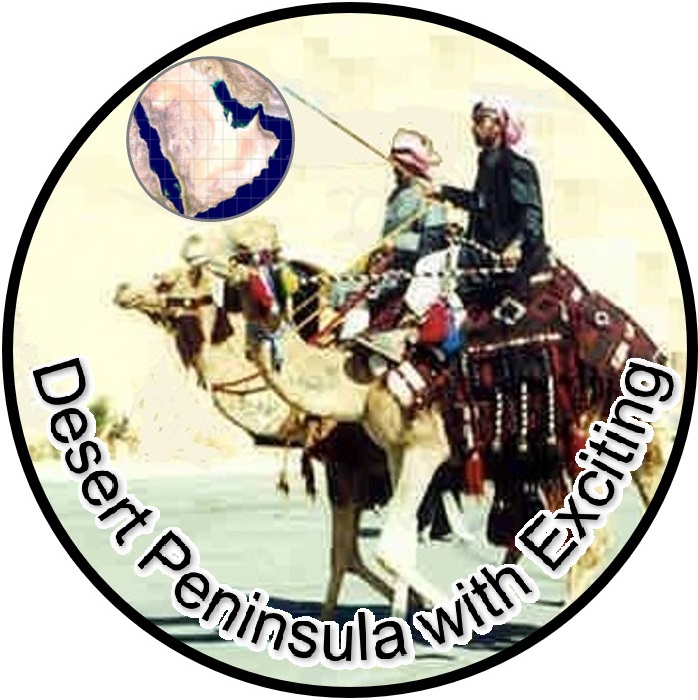Muhammad and the Orthodox Caliphate
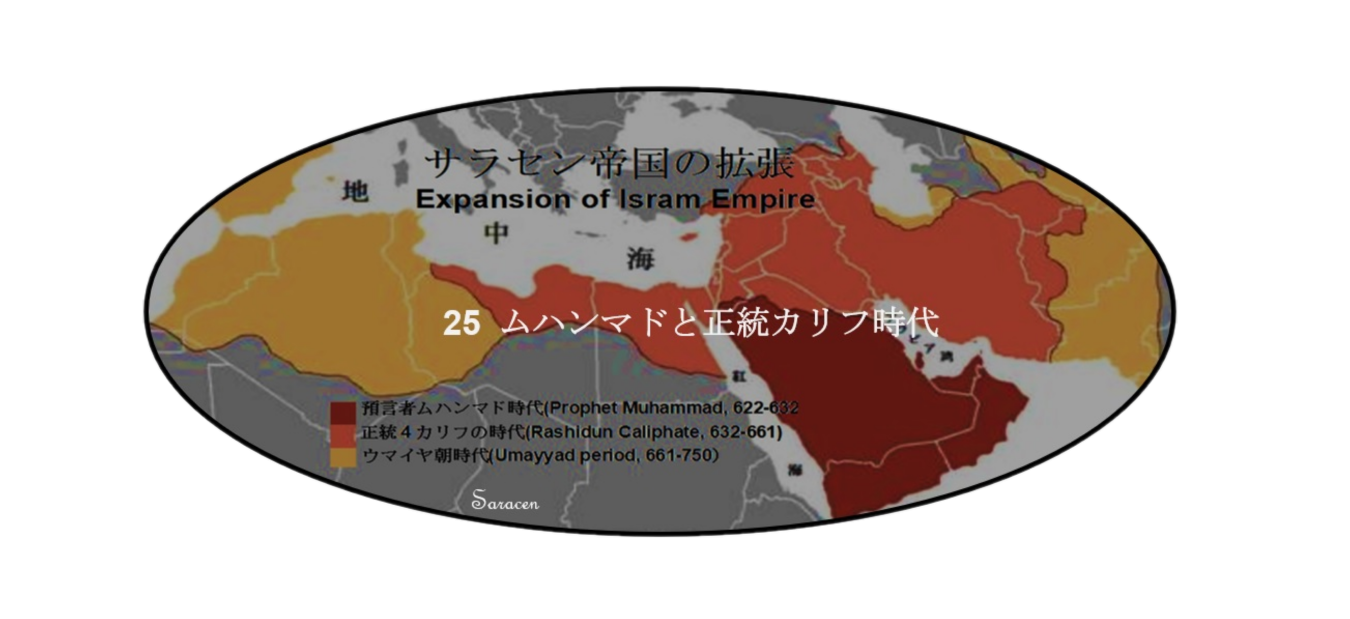
目次(Index)
ムハンマドの血統
生い立ち
最初の啓示
アカバの誓い
ヒジュラ(マディーナへ移住)
マディーナ憲章とイスラーム共同体(ウンマ)
別離の説教
ムハンマド治世下での主な戦役
初代正統カリフ就任
入信者の棄教の動き
リッダの戦い(棄教の戦い)
イスラームの下にアラビア半島統一
イスラームの征服開始
アブー・バクル治世下での主な戦役
第二代正統カリフに就任
イスラームの征服推進
政治的経済的基盤の確立
イスラーム暦とイスラーム法の確立
暗殺未遂とカリフ候補
ウマル治世下での主な戦役
Muhammad’s lineage
Upbringing
First revelation of Allah
Pledge of Aqaba
Hijra (Migrate to Madinah)
Constitution of Madinah and Umma Islamiyah
Muhammad’s Final Sermon
Major campaigns under the reign of Muhammad
Reign of Four Rashidun Caliphs
First Rashidun Caliph Abu Bakr
Abu Bakr proclaimed himself Caliph
Movement of Spreading Apostasy
Ridda Wars (Wars of Apostasy)
Unity of Arabian Peninsula under Islam
Beginning of Muslim Conquests
Major campaigns under Reign of Abu Bakr
Second Rashidun Caliph Umar ibn Khattab
Inaugurated Second Rashidun Caliph
Promotion of Muslim Conquests
Establishing Political & Financial Foundations
Establishing Hijra Calendar & Shariah Law
Assassination Attempt and Caliph Candidates
Major campaigns under Reign of Umar
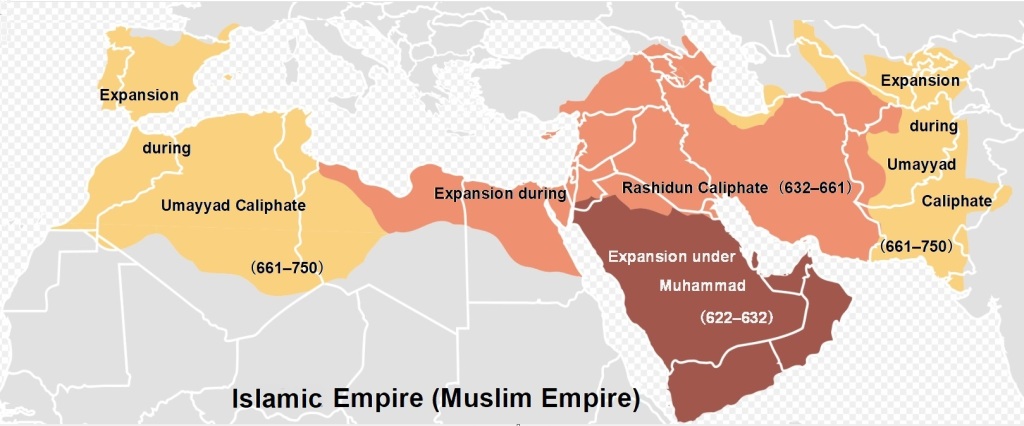
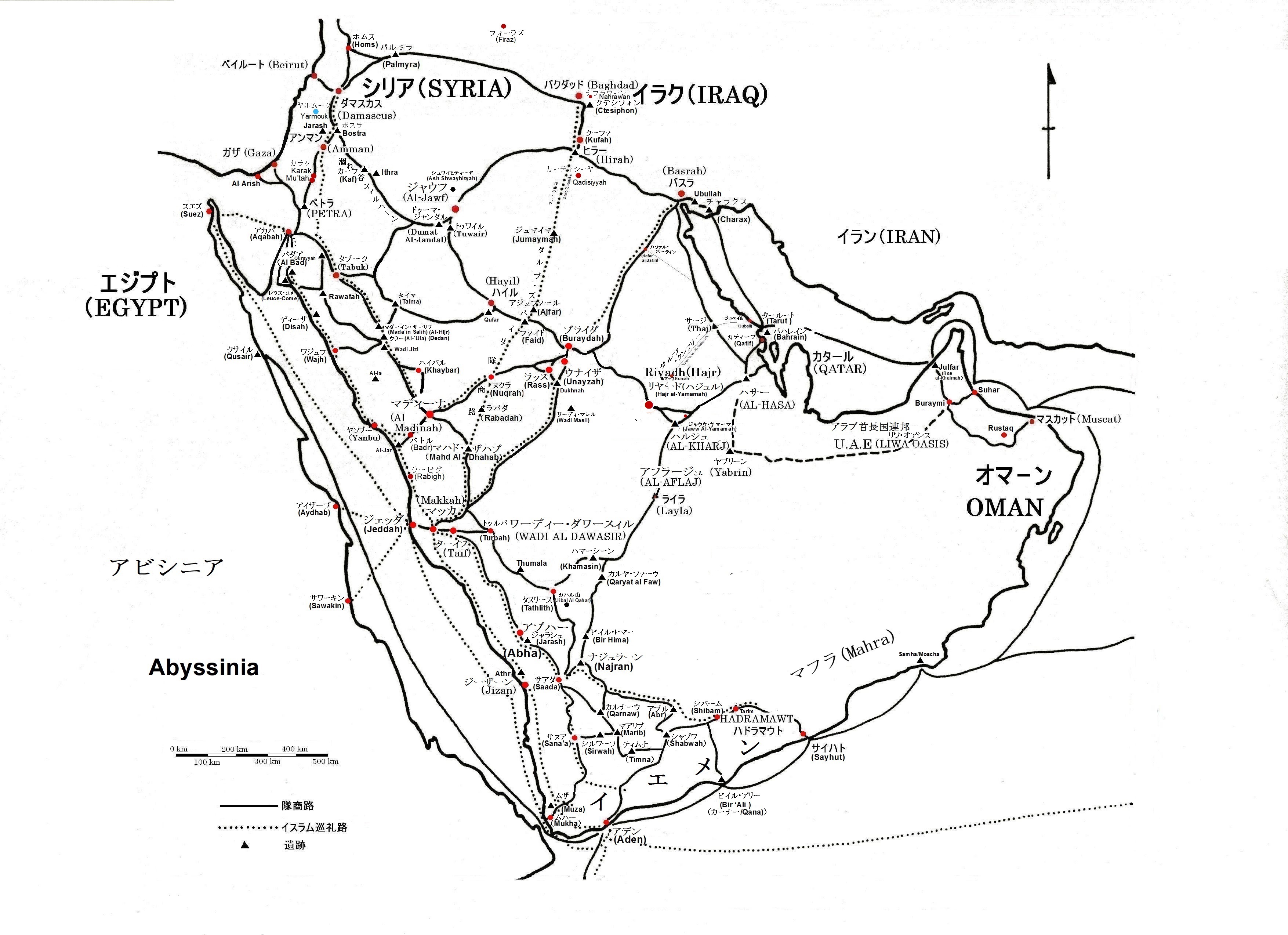
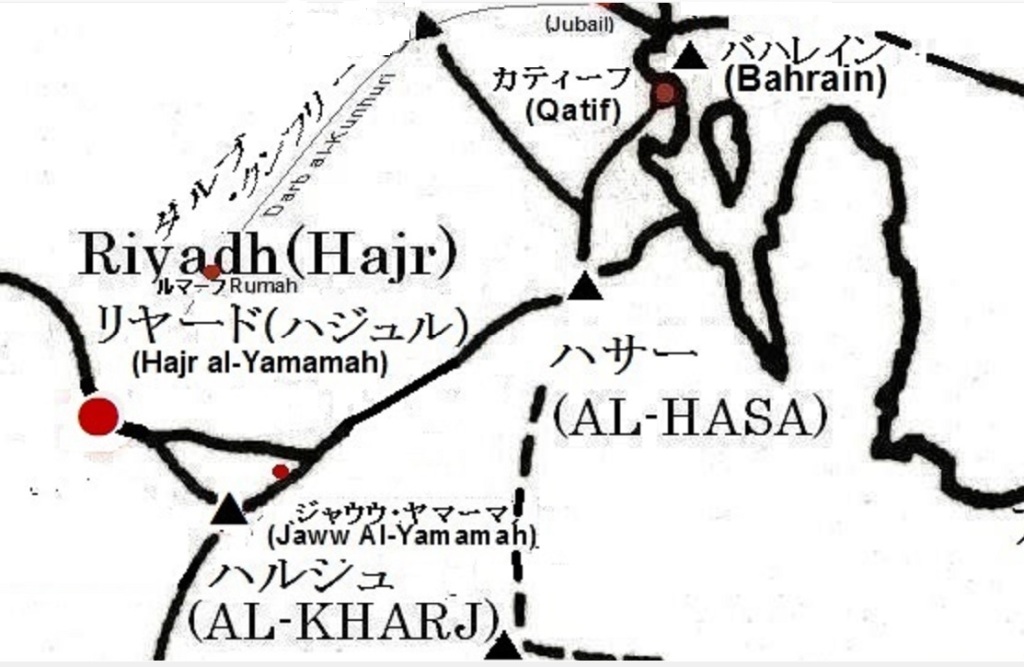
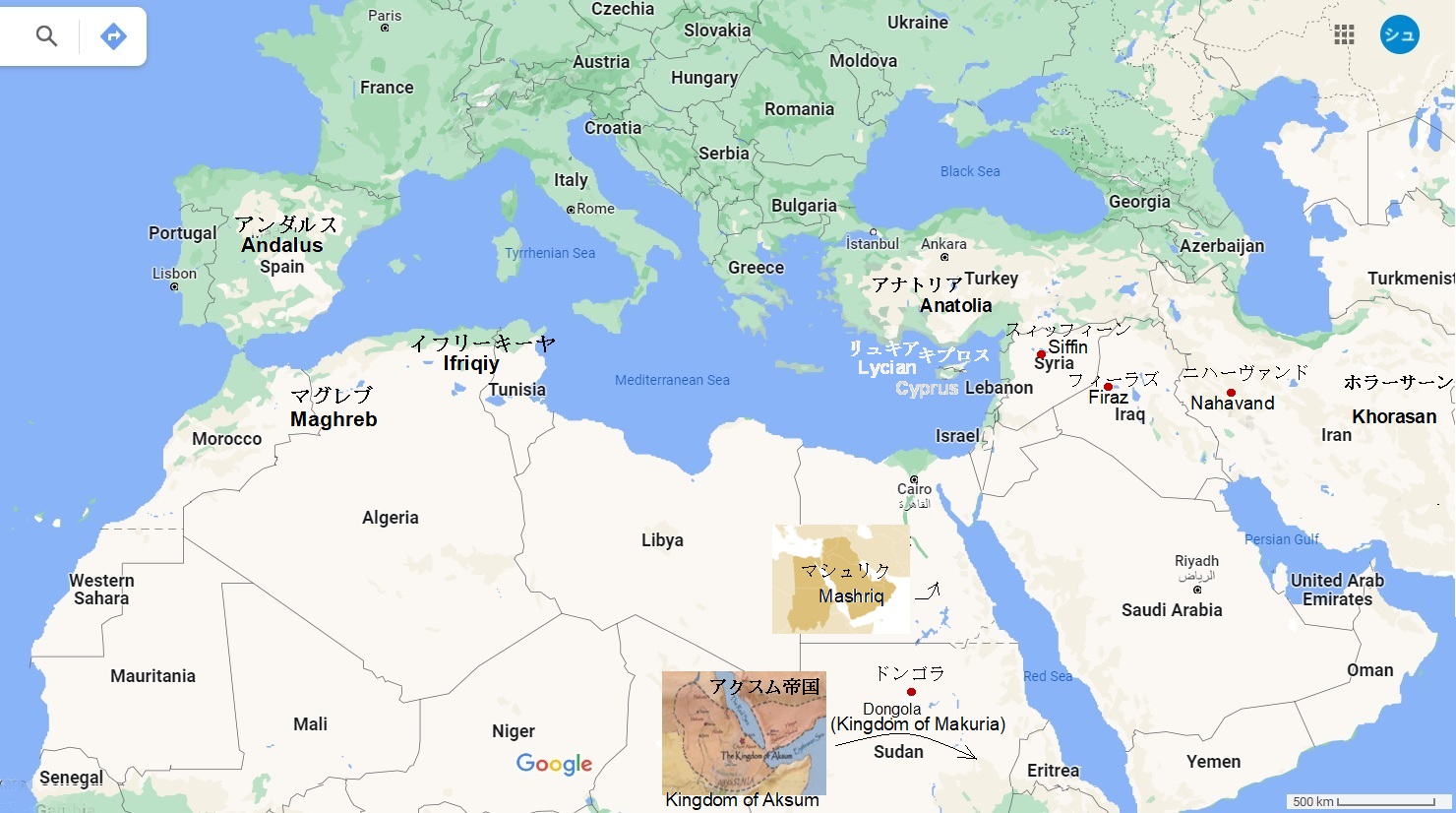
預言者ムハンマド
ムハンマドの血統
イスラーム教開祖ムハンマド・イブン・アブドゥッラー(Muhammad ibn Abdullah) (محمد بن عبد الله بن عبد المطلب)は、570/571年に生まれて632年にマディーナ(المدينة المنورة) (Al Madinah Al Munawwarah)で亡くなっています。ムハンマドの血統はクサイ・イブン・キラーブ(Qusai ibn Kilab ibn Murrah) (c..400~480) (قصي بن كلاب بن مرة)に遡ります。クサイ(Qusai)は、クライシュ族(قريش) (Quraysh)の族長であり、古代聖地メッカ(مكة المكرمة)の守護者をフザーア族(Khuza’a) (خزاعة)から引き継いだ人物です。クサイの孫ハーシム・イブン・アブド・マナーフ(Hashim ibn ‘Abd Manaf) (d. 497 or 510) (هاشم بن عبد مناف) は、有能な統治者でした。ハーシムは、通商路を拡大してメッカを繁栄させるのに成功しました。ハーシム・イブン・アブド・マナーフの子孫は、ハーシム家(House of Hashim) (الهاشميون)と呼ばれています。
Prophet Muhammad
Muhammad’s lineage
The founder of Islam, Muhammad ibn Abdullah (محمد بن عبد الله بن عبد المطلب), was born in 570/571 and died in Al Madinah Al Munawwarah (المدينة المنورة) in 632. Muhammad’s lineage goes back to Qusai ibn Kilab ibn Murrah (c..400~480) (قصي بن كلاب بن مرة). Qusai was the chieftain of Quraysh tribe (قريش) and he succeeded Khuza’a tribe (خزاعة) as the guardian of the ancient sacred site of Mecca (مكة المكرمة). Qusay’s grandson Hashim ibn ‘Abd Manaf (d. 497 or 510) (هاشم بن عبد مناف) was a competent ruler. Hashim succeeded in expanding trade routes and making Mecca prosperous. The descendants of Hashim ibn ‘Abd Manaf are called Hashemite (House of Hashim) (الهاشميون).
生い立ち
ムハンマドは、570年に孤児として生まれました。父親は、ハーシムの孫アブドゥッラー・イブン・アブドゥルムッタリブ(Abd Allah ibn Abd al-Mutalib) (545~ 570)(عبد الله بن عبد المطلب) で、母親は、クサイの兄弟の子孫アーミナ(Aminah bint Wahb) (d. 577) (آمنة بنت وهب) です。570年は、戦闘用の象を引き連れてマッカを襲ったエチオピア軍が神の奇跡で退けられたため、「象の年」と呼ばれています。ムハンマドは2歳になるまで養母のハリーマ(Halimah)夫妻と過ごしました(ハリーマ・ビント・アビー・ズアイブ)(حليمة بنت أبي ذؤيب) (Halimah bint Abi Dhuayb)。6歳で母アーミナを失い、8歳で祖父アブドゥルムッタリブ・イブン・ハーシム (‘Abd al-Muttalib ibn Hashim) (c. 497~578) (عبد المطلب بن هاشم)も亡くしたので、ハーシム家の家長アブー・タリーブ(Abu Talib ibn Abd al-Muttalib) (549~ 619) (أبو طالب بن عبد المطلب) の庇護を受けて育ちました。
Upbringing
Muhammad was born an orphan in 570. His father was Abd Allah ibn Abd al-Mutalib (545~570) (عبد الله بن عبد المطلب), and his mother was a descendant of Qusay’s brother, Aminah bint Wahb (d. 577) (آمنة بنت وهب) . The year 570 is called the “Year of the Elephant” because the Ethiopian army, that attacked Makkah with the fighting elephants, was defeated by a miracle of God. Muhammad lived with his nanny, Halimah bint Abi Dhuayb (حليمة بنت أبي ذؤيب), until he was two years old. He lost his mother Armina at the age of six and his grandfather Abd al-Muttalib ibn Hashim (c. 497 ~578) (عبد المطلب بن هاشم) also died. So, Muhammad was brought up under the patronage of the Hashemite patriarch Abu Talib ibn Abd al-Muttalib (549~619) (أبو طالب بن عبد المطلب) .
最初の啓示
ムハンマドは商人と成り、その正直な性格の為にアラビア語で「信義にあつい」あるいは「信用できる」等を意味するアーミーン(آمين) (Amin)と云うあだ名を得て、公平な仲裁人にも選ばれています。その評判で595年に40歳の未亡人ハディージャ・ビント・フワイリド(Khadijah bint Khuwaylid) (555~619) (خديجة بنت خويلد) から求婚されて、彼女と結婚しました。そして、時には、金持ちで貞節な妻の隊商を率いたりもしました。
その一方でムハンマドは毎年、数週間にわたって近郊のヒラー山(حراء) (Hira)の洞窟で瞑想をしており、610年に最初の啓示を受けたと云われています。妻、従兄妹や友人から始め、613年頃にムハンマドは公にイスラーム(الإسلام) (Islam)伝道を始めました。ムハンマド自身の部族であるクライシュ族(Quraysh) (قريش)は、多神教の偶像を崇拝しており、ムハンマドとその信徒達に対し迫害と虐待を加えました。このために615年に信徒達の一部はアビシニアのアクスム帝国への移住を余儀なくされました。
First revelation of Allah
Muhammad became a merchant and, because of his honest nature, he has earned the nickname Armin (آمين) (Amin), which means “faithful” or “trustworthy” in Arabic, and has been chosen as an impartial arbitrator.
On that reputation he was courted by the forty-year-old widow Khadijah bint Khuwaylid (555~619) (خديجة بنت خويلد) and married her in 595. Sometimes he led the caravans of his rich and chaste wife.
Muhammad, meanwhile, meditated every year for several weeks in a cave on nearby Mount Hira and it is said that he received his first revelation of Allah (الله) in 610. Starting with his wife, cousins and friends, Muhammad began his public evangelism to Islam (الإسلام) around 613. Muhammad’s own tribe, Quraysh (قريش), worshipped polytheistic idols and persecuted and abused Muhammad and his followers. This forced some of the believers to migrate to Kingdom of Aksum (c 50~c 940) of Abyssinia in 615.

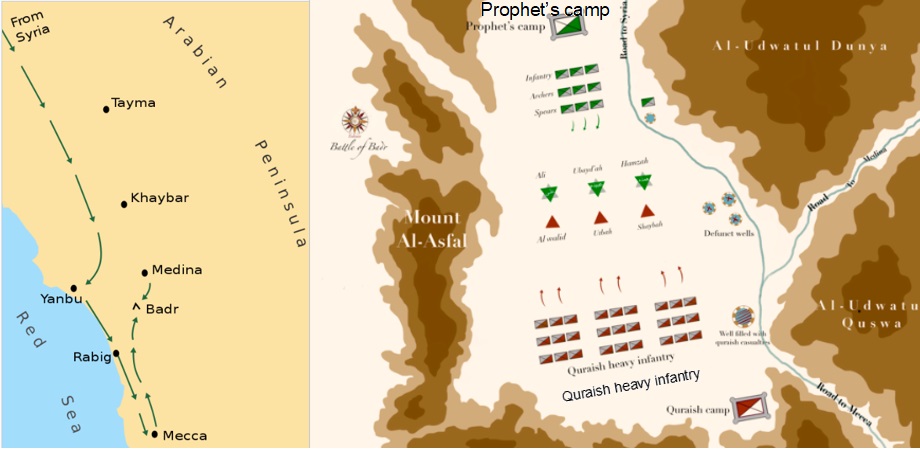
アカバの誓い
619年に庇護者であった伯父アブー・タリーブが没し、ムハンマドに対するハーシム家一門の保護が無くなっていまいました。そのため、メッカに住んでいたムハンマドとその信徒達は、死の危険にさらされました。ムハンマドは主要な市ターイフ(Taif) (الطائف)を訪問してそこでの保護を求めようとしました。しかしながら、その努力は失敗しただけではなく、ムハンマドは、身体までも傷つけられました。
幾つかのターイフとの交渉が不調に終わった後にムハンマドはヤスリブ(يثرب) (Yathrib)(後のマディーナ(Madinah))から来た数人の男達に希望を見出すことができました。75名のマディーナ住人がメッカ (Mecca) (مكة المكرمة)への巡礼とムハンマドに会う為にやってきました。夜間、秘密裏にムハンマドに会って「アカバの誓い (Second Pledge of al ‘Aqaba)」或は「戦いの誓い(People of War)」として知られる誓いを行いました。その後、ヤスリブの主要な12の一門の代表からなる使節が中立の外部者であるムハンマドをマディーナ社会全体の首席仲裁人として招聘してきました。
Pledge of Aqaba
In 619, his protector his uncle Abu Talib died, and the protection of the Hashim family against Muhammad was gone. Therefore, Muhammad and his followers who lived in Mecca were in danger of death. Muhammad tried to visit the main city of Taif (الطائف) and seek protection there. However, not only did his efforts fail, but Muhammad was also physically injured.
After some failed negotiations with Taif, Muhammad was able to find hope in a few men from Yathrib (يثرب) (later Madinah). Seventy-five Madinah residents came to Mecca (مكة المكرمة) to make a pilgrimage and meet Muhammad. They met Muhammad secretly at night and took the oath, that is known as the ‘Second Pledge of Aqaba’ or ‘People of War’ (بيعة العقبة). Later, another envoy, consisting of representatives of Yathrib’s 12 main branches, came again and invited a neutral outsider, Muhammad, as the chief arbitrator of the entire Madinah society.
(注)アカバの誓い
マディーナ(Madinah)のアラブ部族が預言者に行った信仰の誓いが、ヒジュラ(Hegira or Hijra)(聖遷)の要因となりました。アカバ(Aqaba)はマッカ(Makkah)郊外、ミナーの谷(Mina)あたりで、621年にマディーナからの巡礼者達12名がムハンマド(Muhammad)と会見し、「女性の誓い」を行いました。これは第1次アカバの誓い(First Pledge of al-‘Aqabah)と呼ばれ、「アッラー(Allah)を唯一の神と見なし、盗み、姦通、嬰児殺し、虚言をしない。神の使徒に服従する。誓いを果たした場合に楽園が約束される。誓いを破った場合に神の裁きが下される」との内容を持っていました。十戒との類似が指摘されていますし、クルアーン(Qur’an) 60章12節にもほぼ同様の内容が見られます。その後、預言者は腹心のムスアブ・イブン・ウマイル(Mus’ab ibn ‘Umayr) (d. 625) (مصعب بن عمير) をマディーナに送り、イスラーム(Islam)の布教にあたらせました。翌年、マディーナの73名の男と2名の女がアカバで預言者と会見し、神の使徒を守る為には戦いも辞さないと誓いました。これが「戦いの誓い(People of War)」で「第2次アカバの誓い(Second Pledge of ‘Aqaba)」と呼ばれています。これによってムハンマドはマディーナへの移住を決意しました。(出典: 岩波イスラーム辞典)
Note: Bay’s al-‘Aqaba (Pledge of Aqaba) (بيعة العقبة)
An oath of faith made by the Arab tribes of Madinah to the Prophet that contributed to the Hegira or Hijra (sacred passage). Aqaba is at around the valley of Mina, a suburb of Makkah. Here, in 621, 12 pilgrims from Medinah met with Muhammad and took the “Women’s Vows”. This is called “First Pledge of al-‘Aqabah”, and it says, “Regard Allah as the only God, do not steal, commit adultery, do not lie, and submit to God’s Messengers. Paradise is promised if you fulfill your vow. If you break your oath, you will be judged by God.” Similarities with “Ten Commandments” have been pointed out, and almost the same is found in Qur’an 60:12. The Prophet then sent his confidant Mus’ab ibn ‘Umayr (d. 625) (مصعب بن عمير) to Madinah to preach Islam. The following year, 73 men and two women from Madinah met again with the Prophet at Aqaba and vowed to fight to protect God’s messengers. This is called the “People of War” and the “Second Pledge of ‘Aqaba”. This led Muhammad to decide to move to Madinah.
(Source: Iwanami Islamic Dictionary)
ヒジュラ(マディーナへ移住)
ヤスリブ(マディーナ)ではバヌー・アウス族(Banu Aus) (بنو أوس)とバヌー・ハズラジュ族(Banu al-Khazraj) (بنو خزرج)が6世紀初めから120年間にわたって戦っていました。最後のブアースの戦い(Battle of Bu’ath) (617)(معركة بعاث) に起因する主張への意見の相違から部族間の血讐や「目には目を」の概念が圧倒的に強まりました。その結果、論争に裁定を下せる権威を持った人間無しには部族間で調整し、和睦することは不可能になっていました。
その様な裁定者としてムハンマドを受け入れようと、ヤスリブはムハンマドに使節を送りました。ヤスリブからの使節は、「自分達自身と仲間の市民達がムハンマドをヤスリブの市民社会に受け入れ、自分達の1員として保護する」ことを誓いました。こうしてムハンマドとその信徒達は622年までに大きな農業オアシスであったヤスリブ(マディーナ)へと移住しました。この移住はアラビア語では「出発」または「移住」を示すヒジュラ(Hijra) (هجرة)と呼ばれ、ユリウス暦(Julian calendar) の622年7月16日です。それ以降、ヤスリブ(マディーナ)では、イスラーム教徒移住者達は、ムハージルーン(Al-Muhajirun) (المهاجرون)と呼ばれ、イスラーム教徒移住者達が避難所を見つけるのを助けたマディーナの住人達は、アンサール(Al Ansar) (الأنصار)として呼ばれました。
Hijra (Migrate to Madinah)
In Yathrib (Madinah), Banu Aus (بنو أوس) and Banu al-Khazraj (خزرج) had been fighting for 120 years from the beginning of the 6th century. Disagreement over claims resulting from the final Battle of Bu’ath (617)(معركة بعاث) had increasingly reinforced the relation, between the both tribes, of blood animosity and an eye for an eye. As a result, it became impossible to coordinate and reconcile between the both tribes without someone with authority to adjudicate disputes.
To accept Muhammad as such an arbiter, Yathrib sent an envoy to Muhammad. The envoy from Yathrib vowed that “they and their fellow citizens accept Muhammad into Yathrib’s civil society and protect him as one of their members.” By 622, Muhammad and his followers had moved to Yathrib (Madinah), a large agricultural oasis. This migration is called Hijra (هجرة), which means “departure” or “migration” in Arabic, and is known in the Julian calendar on July 16, 622. From then on, in Yathrib (Madinah), Muslim migrants form Makka were called the A l-Muhajirun (المهاجرون) while the inhabitants of Madinah, who helped Muslim migrants found refuge, were called Al ansar (الأنصار).
マディーナ憲章とイスラーム共同体(ウンマ)
マディーナの部族間での長年にわたる争いの因をおさめる為にムハンマドが最初にした事は、マディーナ憲章(Constitution of Medinah) (دستور المدينة) or (Charter of Medinah) (المدينة صحيفة)として知られた文章の草案作りでした。この憲章はマディーナ8部族およびメッカから移住してきたイスラーム教徒達の間の同盟あるいは連盟を設立する為にすべての市民の権利と義務およびイスラーム共同体や特にユダヤ教徒およびその他の啓典の民等の共同体を含むマディーナに共住する異なる共同体の結びつきを明記していました。マディーナ憲章にイスラーム共同体(ウンマ(Umma Islamiya) (أمة))と定義された共同社会は、宗教的外観を持っていました。しかしながら実際的な配慮によっても形作られ、古いアラブ部族の法律上の形をしっかりと保っていました。従って、最初のイスラーム教国(Muslim Empire and Islamic Empire) (عالم إسلامي)がこの憲章によって事実上、設立されたことに成ります。
Constitution of Madinah and Umma Islamiyah
The first thing Muhammad did to settle the long-standing strife among the tribes of Madinah was to create a Constitution of Madinah (دستور المدينة) or Charter of Madinah (المدينة صحيفة). This Charter establishes the rights and duties of all citizens among the Islamic community to establish an alliance or federation among the eight Madinah tribes and Muslims who have migrated from Mecca. It also clearly states the bonds between different communities that live together, in particular the Jewish and the other communities of the Scriptures. The communal society, defined in the Charter of Madinah as an Islamic community (Umma Islamiyah (أمة)), had not only a religious appearance, but also it was shaped by the practical considerations and retained the legal form of the old Arab tribes. Thus, the first Islamic Empire (عالم إسلامي) was effectively established by the Charter of Madinah.
別離の説教
マディーナへ移住してから10年目の年の終わりにムハンマドは最初のほんとうの意味でのメッカへのイスラーム巡礼を行いました。巡礼を終えてマディーナに戻る途中に涸れ谷ラービグ(Wadi Rabigh) (وادي رابغ)内のフンム池(Ghadir Al-Khumm) (غدير الخم)でムハンマドは「別離の説教(Muhammad’s Final Sermon) (خطبة الوداع)」として知られる有名な演説を行いました。この説教についてはスンナ派(スンニー派)解釈とシーア派解釈は異なっています。最後の巡礼の数ヵ月後にムハンマドは病に倒れ、数日間に頭痛と脱力感にみまわれました。ムハンマドは632年6月8日(享年63歳)マディーナで亡くなりました。
Muhammad’s Final Sermon
At the end of the tenth year of his migration to Madinah, Muhammad made the first true Islamic pilgrimage to Mecca. On the way back to Madinah after the pilgrimage, we went to the Ghadir Al-Khumm (غدير الخم), Muhammad delivered a famous speech known as the “Muhammad’s Final Sermon (خطبة الوداع)”. Sunni (Sunni) and Shia interpretations of this sermon are different. A few months after his last pilgrimage, Muhammad fell ill and suffered from headaches and weakness for several days. Muhammad died in Madinah on June 8, 632 (aged 63).
ムハンマド治世下での主な戦役
| バドルの戦い | 624年3月 | ムスリム軍勝利 |
| 戦場: マディーナ南西の隊商路に位置するバドル | 敵軍: アブー・ジャフル率いるメッカ軍900名 | ムスリム軍: ムハンマド率いる300名の戦士 |
| 戦果: メッカ軍45名を殺害、捕虜70名の身代金 | メッカとの間の武装闘争開始 | マディーナでのムハンマドの立場を強化 |
| ウフドの戦い | 625年3月 | ムスリム軍敗北 |
| 戦場:マディーナ北方5kmのウフド山 | 敵軍: アブー・スフヤーン率いるメッカ軍3,000名 | ムスリム軍: ムハンマド軍 |
| 戦果: イスラーム教徒達撲滅の失敗 | ||
| 塹壕の戦い | 627年3~4月 | ムスリム軍勝利 |
| 戦場: マディーナの周囲 | 敵軍: アブー・スフヤーン率いるメッカ軍10,000名 | ムスリム軍: ムハンマド率いる3,000名 |
| 戦果: メッカ側敗戦による名声とシリア交易喪失 | ||
| フダイビーヤの休戦 | 628年3月 | 取り決めを調印 |
| 戦場: メッカの直ぐ外のフダイビーヤ | 敵軍: メッカ軍騎兵隊200名 | ムスリム軍: ムハンマド率いるイスラーム教徒1,400名 |
| 戦果: 敵対関係の停止 | イスラーム教徒達の巡礼の翌年への延期 | 保護者無認可マディーナ在住メッカ住人の送還 |
| ハイバル遠征 | 628年5~6月 | ムスリム軍勝利 |
| 戦場: マディーナの北約140kmのオアシス・ハイバル | 敵軍: ユダヤ教徒のナディール族 | ムスリム軍: ムハンマド率いるムスリム軍 |
| 戦果: ナツメヤシの実や穀物の収穫の半分 | ||
| ムウタの戦い | 629年9月 | ムスリム軍敗北 |
| 戦場: カラクとヨルダン川東のムウタ村 | 敵軍: ビザンチン帝国軍10万人 | ムスリム軍: 3,000人 |
| 戦果: 中東全域を震撼、イスラームに改宗相次ぐ | この戦いでイスラーム軍はガッサーン朝等ヨルダン東部のアラブ族征服に失敗した | |
| メッカ征服 | 630年1月 | ムスリム側勝利 |
| 戦場: メッカ | 敵軍: メッカ住民 | ムスリム側: 10万人の巡礼者 |
| 戦果: メッカを制圧 | メッカ住人達のイスラーム教への改宗 | カアバ神殿内外の全て偶像の破壊 |
| フナインの戦い | 630年 | ムスリム軍勝利 |
| 戦場: ターイフ近傍のフナイン | 敵軍: ハワージン族とサキーフ族の同盟軍4,000名 | ムスリム軍: 12,000人 |
| 戦果: 一年後、サキーフ族降伏、イスラームに改宗 | ||
| タブーク遠征 | 630年10月 | ムスリム軍は戦わずしての勝利 |
| 戦場: タブーク | 敵軍: ビザンチン帝国軍のアラビア侵攻阻止 | 敵軍: ビザンチン帝国軍 |
| 戦果: ビザンチン帝国衛星国のイスラームへの改宗 | 無血勝利でのムスリム内部団結強化 |
Major campaigns under Muhammad’s reign
| Battle of Badr | March 624 AD | Victory of Muslim army |
| Battlefield: Badr, located on the caravan route southwest of Madinah | Enemy forces: Makkan force of 900 led by Abu Jahl | Muhammad Army: A 300-man assault force led by Muhammad |
| Battle Results: Killed 45 Makkan (Meccan) soldiers, 70 prisoners paid for ransom to Muhammad | Start of armed struggles with Mecca | Strengthen Muhammad’s position in Medina (Madinah) |
| Battle of Uhud | March 625 AD | Defeat of Muslim army |
| Battlefield:Mount Uhud, 5 km north of Medina | Enemy: Makkan army of 3,000 men, led by Abu Sufyan ibn Harb | Muslim army: Muhammad army |
| Battle Result: failure to eradicate Muslims | ||
| Battle of the Trench (Battle of Khandaq) | March~April 627AD | Victory of Muslim army |
| Battlefield: Surrounding perimeter of Medina | Enemy forces: Meccan confederate armies of 10,000 led by Abu Sufyan ibn Harb | Muslim army: 3,000men led by Muhammad |
| Battle Result: Meccan side lost fame and trade with Syria due to defeat | Muslim army besieged the area of the Banu Qurayza tribe, leading to their surrender | |
| Truce of Hudaybiyyah | January 628 AD | Treaty of Hudaybiyyah |
| Battlefield: Hudaybiyah just outside Mecca | Enemy: Makkan army of 200 cavalries | Muslim army:1,400 muslims on umrah pilgrimage led by Muhammad |
| Battle Result: affirmed peace for a period of 10 years | Postponed Muslim pilgrimage to following year and return in a peaceful pilgrimage | Repatriation of Meccans who migrated to Medina without parental permission |
| Expedition to Khaybar (Battle of Khaybar) | May & June 628 AD | Victory of Muslim army |
| Battlefield: Khaybar, an oasis located 140 km from Medina | Enemy: Banu Nadir of Jewish tribe | Muslim army: Early Muslims led by Muhammad |
| Battle results: Half of a date palm and grain harvest | ||
| Battle of Mu’tah | September 629 AD | Defeat of Muslim army |
| Battlefield:Karak, and Mu’tah at east of Jordan River | Enemy: Byzantine Empire and their Ghassanid vassals, of 100,000 men | Muslim army: 3,000 men |
| Battle results: Shaking the whole Middle East, one after another converted to Islam | In this battle, the Islamic army failed to conquer the Arabs in eastern Jordan, including the Ghassanids. | |
| Conquest of Mecca | January 630 AD | Victory of Muslim army |
| Battlefield: Mecca | Enemy:Meccan inhabitants mainly Quraysh tribe | Muslim army: 10,000 soldiers and pilgrimage of 100,000 |
| Battle results: End of Muslim–Quraysh war | Meccan inhabitants converted to Islam | Destruction of all idols inside and outside Kaaba |
| Battle of Hunayn | 630 AD | Victory of Muslim army |
| Battlefield: Hunayn valley near Taif | Enemy: 4,000 Hawazin and Thaqif allies | Muslim army: 12,000 men |
| Battle results: A year later, Thaqif tribe surrendered and converted to Islam. | Muslims captured enormous spoil | |
| Expedition to Tabuk | October 630 AD | Muslim army won without fighting |
| Battlefield: Tabuk | Enemy: Byzantine imperial army | Muslim army:a force of 30,000 men led by Muhammad |
| Battle results:Byzantine empire’s satellite states converted to Islam | Strengthening internal unity of Muslims in bloodless victory | Stopping Byzantine invasion of Arabia |
正統四カリフの時代
イスラーム帝国の初代カリフから第四代カリフまでを正統四カリフの時代(632~661)と呼んでいます。この時代は預言者ムハンマドの亡くなった632年に始まり、預言者ムハンマドの代理人である4人の正統カリフによって統治されていました。正統四カリフの時代の最盛期にはイスラーム共同体(ウンマ)すなわちイスラーム帝国は、マシュリク(Mashriq) (مشرق)から北アフリカ、コーカサス(カフカース(Caucasus))(قفقاز)、イラン高原、中央アジアへとその版図を広げました。その初代正統カリフがアブー・バクルです。
Reign of Four Rashidun Caliphs
The period from the first caliph to the fourth caliph of the Islamic empire is called the era of the four Rashidun caliphs (632-661). This era began with the death of Prophet Muhammad in 632 AD and was ruled by four Rashidun caliphs who were representatives of Prophet Muhammad. At its height during the period of the four Rashidun caliphs, the Islamic Community (Umma) or Islamic Empire stretched and expanded its teritory from Mashriq (مشرق) to North Africa and from Caucasus (قفقاز) to Iranian Plateau and Central Asia. The first orthodox caliph is Abu Bakr.
(注)マシュリク(مشرق)は、太陽が昇る東を意味し、太陽が沈む西アラビアを意味するマグレブ(المغرب )に対し、アラビア半島、レバント、エジプト、ヌビアを含む東アラビアを指します。
Note: Mashriq (مشرق) means the east of the rising sun and refers to Eastern Arabia, including Arabian Peninsula, Levant, Egypt and Nubia, as opposed to Maghreb (المغرب), which means western Arabia where the sun sets.
正統四カリフの時代(Rashidun Caliphate)(632~661)
| 正統カリフ(Rashidun Caliphs) | 名 前 (Name of each Rashidun Caliph) | 統治期間(reign period) |
| 初代正統カリフ(1st Rashidun Caliph) | アブー・バクル・スィッディーク(Abu Bakr Al-Siddiq)( أبو بكر الصديق) | 632~ 634 |
| 第二代正統カリフ(2nd Rashidun Caliph) | ウマル・イブン・ハッターブ(Umar ibn al-Khattab)(عمر بن الخطاب) | 634~644 |
| 第三代正統カリフ(3rd Rashidun Caliph) | ウスマーン・イブン・アッファーン(Uthman ibn Affan)(عثمان ابن عفّان) | 644~ 656 |
| 第四代正統カリフ(4th Rashidun Caliph) | アリー・イブン・アビー・ターリブ(Ali ibn Abi Talib)(علي بن أبي طالب) | 656~ 661 |

